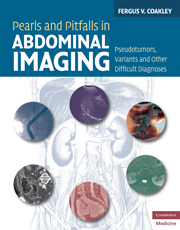Book contents
- Frontmatter
- Contents
- Preface
- Acknowledgements
- Section 1 Diaphragm and adjacent structures
- Section 2 Liver
- Section 3 Biliary system
- Section 4 Spleen
- Section 5 Pancreas
- Section 6 Adrenal glands
- Section 7 Kidneys
- Section 8 Retroperitoneum
- Section 9 Gastrointestinal tract
- Section 10 Peritoneal cavity
- Section 11 Ovaries
- Section 12 Uterus and vagina
- Case 79 Pseudotumor due to differential enhancement of the cervix
- Case 80 Early intrauterine pregnancy on CT and MRI
- Case 81 Prolapsed uterine tumor mimicking cervical cancer
- Case 82 Nabothian cysts
- Case 83 Vaginal pessary
- Section 13 Bladder
- Section 14 Pelvic soft tissues
- Section 15 Groin
- Section 16 Bone
- Index
- References
Case 82 - Nabothian cysts
from Section 12 - Uterus and vagina
Published online by Cambridge University Press: 05 November 2011
- Frontmatter
- Contents
- Preface
- Acknowledgements
- Section 1 Diaphragm and adjacent structures
- Section 2 Liver
- Section 3 Biliary system
- Section 4 Spleen
- Section 5 Pancreas
- Section 6 Adrenal glands
- Section 7 Kidneys
- Section 8 Retroperitoneum
- Section 9 Gastrointestinal tract
- Section 10 Peritoneal cavity
- Section 11 Ovaries
- Section 12 Uterus and vagina
- Case 79 Pseudotumor due to differential enhancement of the cervix
- Case 80 Early intrauterine pregnancy on CT and MRI
- Case 81 Prolapsed uterine tumor mimicking cervical cancer
- Case 82 Nabothian cysts
- Case 83 Vaginal pessary
- Section 13 Bladder
- Section 14 Pelvic soft tissues
- Section 15 Groin
- Section 16 Bone
- Index
- References
Summary
Imaging description
Nabothian cysts, named after the German anatomist Martin Naboth who first described them in 1707 [1], are retention or inclusion cysts of the uterine cervix that probably develop when chronic cervicitis results in blockage to the ducts of the mucus-secreting glands of the endocervix [2,3]. At imaging, Nabothian cysts are seen as one or more well-circumscribed unilocular cysts abutting the endocervical canal that are usually a few mm in diameter but occasionally reach 4 cm or more (Figure 82.1) [4, 5]. The term “tunnel cluster” has been applied when multiple small Nabothian cysts are grouped together around the endocervical canal (Figure 82.2) [6], but the value of this term is questionable.
Importance
Incidentally detected Nabothian cysts, particularly at CT (Figure 82.3), may give rise to unjustified concerns of cervical carcinoma, resulting in unnecessary workup and patient anxiety.
Typical clinical scenario
Nabothian cysts are usually easily diagnosed clinically by visual inspection, or are incidental findings at imaging performed for unrelated reasons. Occasionally, extensive cyst formation or large cysts located deeper in the cervix may produce unexplained cervical enlargement and then imaging with ultrasound or MRI may be helpful in further assessment [7].
Differential diagnosis
Solitary Nabothian cysts are distinctive and generally do not carry an imaging differential. When multiple (i.e., tunnel cluster), the primary differential consideration for Nabothian cysts is adenoma malignum, a rare and aggressive mucinous form of cervical cancer that appears as a multicystic mass within the cervix, in contrast to the solid infiltrative appearance of standard non-mucinous cervical cancer.
Information
- Type
- Chapter
- Information
- Pearls and Pitfalls in Abdominal ImagingPseudotumors, Variants and Other Difficult Diagnoses, pp. 286 - 289Publisher: Cambridge University PressPrint publication year: 2010
